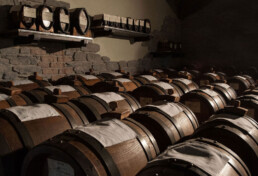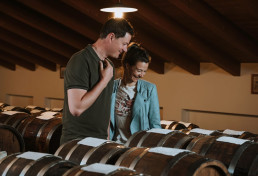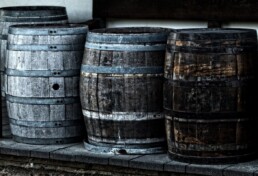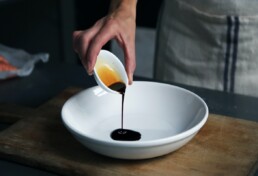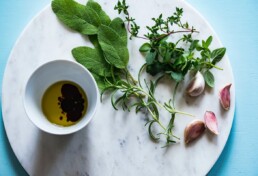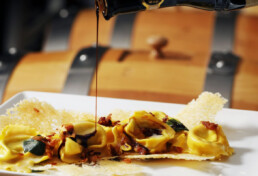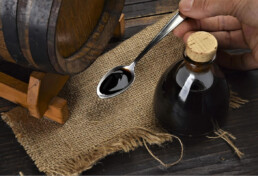Balsamic vinegar: a bit of history... and a guided tour of the vinegar cellar afterwards!
The history of balsamic vinegar is deeply linked to the Modena area and has its roots in a centuries-old tradition. The latter, in 2000, led the traditional product to obtain Protected Designation of Origin (PDO) status. In 2009, it allowed the condiment made by adding wine vinegar to cooked must to be included by the European Commission in the register of I.G.P. (Protected Geographical Indication) products. Let's take a look at the main stages of balsamic vinegar, from the past to the present, and how to learn more about them on a guided tour through the vinegar cellar.
The Traces in Ancient Rome
We all know that balsamic vinegar is of Italian origin, but few of us know that the history of this condiment has very ancient origins. We find, in fact, some traces of its production and use as far back as the Middle Eastern civilisations of the 3rd millennium BC and, above all, during the period of the Ancient Romans. It was here that the cooking of grape must was born, typical of the balsamic vinegar production process that can be observed during a guided tour of the vinegar cellar.
Initially, however, must was not used as a condiment. We find evidence of such use in the first book of Virgil's Georgics.
More specifically, it tells of a woman from the Emilian area who used to cook must to put it in barrels and consume it later.
At the court of the Estensi
Over the centuries, the ancestor of balsamic has undergone numerous changes. However, the first concrete evidence of a condiment from the Modena area, similar to balsamic vinegar, dates back to the transfer of the Este family from Ferrara to Modena. In the registers of the Este secret cellars, relating to the year 1747, there is mention of this interesting food and wine product.
The Napoleonic Invasion and the Balsamic Vinegar Trade
.
Until 1796, the year of the Napoleonic invasion, balsamic vinegar was a condiment found only on the tables of the Este dukes. After Napoleon's arrival in Italy, this product began to be known and sold even outside the Duchy of Modena. Producers began to present it at numerous international exhibitions, meeting with great success.
It is also possible to date back to the 19th century the establishment of the first dynasties of producers of balsamic black gold, who are still part of the Consorzio di Tutela today.
Balsamic Vinegar Today
In 1933, balsamic vinegar was officially recognised by the Minister of Agriculture Giacomo Acerbo. It was in 1965, however, that the Official Gazette published the first specification on the ‘Characteristics of composition and method of preparation of Balsamic Vinegar of Modena’. Over time, this condiment has become increasingly popular. It has gained greater appreciation year after year.
Balsamic Vinegar of Modena from Acetaia Marchi and the guided tour of the vinegar cellar
.As we said at the beginning, from the diffusion and appreciation obtained over time, balsamic vinegar has come to obtain some very important recognitions. We at Acetaia Marchi are proud of this and that is why we produce our vinegar by valuing tradition and using top quality grapes. We do not use preservatives or other substances that can alter the authenticity of the dressing.
We only offer products that guarantee a unique and unforgettable culinary experience.
Bring the taste of tradition to the table with Balsamic VinegarTraditional Balsamic Vinegar of Modena D.O.P. and the Balsamic Vinegar of Modena I.G.P. from Acetaia Marchi. Then, do not hesitate to book a guided tour of the acetaia, during which you will discover how this delicious and precious condiment is produced. You certainly won't regret it!
4 things you (may) not know about balsamic vinegar
The balsamic vinegar is a condiment with a rich and complex flavour that has deep roots in the Italian culinary tradition. But how many of us really know everything there is to know about this precious liquid? Here are four things you may not know about Oro Nero di Modena.
1. The long ageing process
While many condiments are ready for immediate use, balsamic is a product that takes time to be ready. Its production is an artisanal process that can take up to decades! The grapes, usually Trebbiano or Lambrusco, are pressed and the must obtained is slowly cooked for hours. Subsequently, the vinegar is aged in wooden barrels, often made of oak or chestnut. Some high-quality traditional balsamic vinegars may even have been aged for 25 or 50 years. This prolonged ageing allows the balsamic vinegar to develop a more complex flavour and a thick, syrupy consistency.
2. The PDO (Protected Designation of Origin) Label of Traditional Balsamic Vinegar of Modena
When you buy a bottle of traditional balsamic vinegar, you are faced with the DOP label. This acronym stands for 'Denominazione di Origine Protetta' (Protected Designation of Origin) and is a quality mark recognised throughout Europe. The PDO label guarantees that the balsamic vinegar has been produced in a traditional and authentic way, following strict quality standards and coming from a specific Italian territory, namely Modena.
3. The Art of Aging
The ageing of balsamic vinegar is a true art. While Balsamic Vinegar of Modena PGI must age for at least 60 days, Traditional must age for at least 12 years. During this long period, the barrels are opened to let air in, thus stimulating the oxidation process and developing the characteristic aroma and flavour of the balsamic. Barrels of different woods and in different sizes are also used: periodically transpassing into smaller barrels, without adding any aromatic substances. These practices require great skill and experience: it is necessary to be able to find the perfect balance between the desired ageing and exposure to air.

Do you want to know more about balsamic vinegar?
As you have seen (and as you certainly already know, if you have tasted it), balsamic vinegar is much more than just a condiment: it is a testament to Italian culinary tradition and art. The next time you pour it on your salad or use it to marinate meat, remember these curiosities that make this condiment so unique and fascinating...
If you would like to find out more and see for yourself how it is prepared, all you have to do is book a visit to the vinegar cellar. You can find more information directly here.
5 reasons to visit an acetaia in Modena
Traditional Balsamic Vinegar of Modena PDO is a culinary treasure that has ancient roots and a unique flavour. Every acetaia in Modena tells a story and a tradition, and offers visitors the opportunity to immerse themselves in the art of producing this precious elixir. Visiting these places ensures a unique experience for lovers of food, Italian culture and more. Ready for a journey into the world of balsamic vinegar? Let's take a look at the five main reasons for visiting an acetaia.
Reason No. 1 - The discovery of a magnificent tradition
Modena, a city in the heart of Emilia-Romagna, is world famous for its vinegar cellars and the production of Traditional Balsamic Vinegar. Inside these places you can discover the secrets of a precious culinary art, handed down from generation to generation. During a guided tour in a vinegar cellar in Modena, you can learn about the different stages of the production processproduction of balsamic vinegar, which is carried out through the fermentation and ageing of cooked grape must.
Reason No. 2 - The barrels that make the difference in every vinegar cellar in Modena
When visiting vinegar cellars, one can also admire the wooden barrels. They play their part in giving balsamic vinegar its unique and complex flavour... and the most fascinating thing is that some of them can even be hundreds of years old! Some of these barrels have therefore been passed from generation to generation and have become silent witnesses to the long history of this delicacy.
Reason No. 3 - Tasting the different varieties
During a visit to a vinegar cellar in Modena, it is possible to taste different varieties of balsamic vinegar, discovering all the nuances of taste and aroma that characterise it. The tasting can help you understand which type you prefer for your culinary preparations.

Motive no. 4 - Contact with nature
A visit to an acetaia in Modena is an experience that allows you to immerse yourself in Italian culture and culinary traditions, discovering a unique product. It also allows you to immerse yourself in nature, walking among the vines that give life to the balsamic vinegar production process.
Reason No. 5 - The History
The history of Traditional Balsamic Vinegar of Modena PDO has its roots in the ancient agricultural tradition of the region. The experience in the vinegar cellar allows not only to discover all the secrets and curiosities of this age-old process, but also to learn about its history and even the anecdotes of the families that have carried on the tradition.
The experience of a guided tour of a vinegar cellar in Modena
As you can see, there is no shortage of reasons to visit vinegar cellars, and the ones we have seen are just a few! A guided tour through an acetaia is an engaging and fascinating experience for lovers of Italian food and culture, but also for the merely curious and even for children.
Would you like to have the opportunity to discover the secrets of the production process, to admire the ancient wooden barrels and to learn the details of the fermentation and ageing phases, as well as the history of balsamic? If you answered yes, we invite you to our acetaia in Modena. You can find more information about our guided tours directly QUI.
Production of Balsamic Vinegar: the types of vineyards and the steps to be taken
Balsamic vinegar is one of Italy's most prized gastronomic products, known the world over for its unique flavour and dense, aromatic consistency. This condiment is produced in the Emilia region, where production methods are handed down from generation to generation. With this in mind, today we talk about the production of Balsamic Vinegar.
High quality is the result of a rigorous production process
.
To produce a high quality Balsamic Vinegar, it is necessary to follow a rigorous production process that requires time, patience and attention to detail. First of all, the vineyards from which the must is made must be carefully selected, using only grapes from our territory. In particular, the most widely used grape varieties for the production of Balsamic Vinegar are Trebbiano and Lambrusco, which give the condiment its characteristic sweet and sour flavour.
Once the must is obtained, it is cooked slowly until it reaches a dense, dark consistency and is reduced to about half of its original volume. The cooked must is then left to ferment naturally for a longer or shorter period of time, depending on the product to be prepared (Balsamic Vinegar of Modena PGI or Traditional Balsamic Vinegar of Modena PDO). Ageing takes place in carefully selected wooden barrels, in which the balsamic acquires its characteristic flavour and aroma.
The end result is in any case a condiment with an intense and complex flavour, perfect to enrich many traditional Italian dishes and desserts.
The Vineyards Selected for Balsamic Vinegar Production
.
The choice of vineyards is a key factor in the production of an excellent balsamic that can be awarded the PGI or PDO label. Most of the vineyards used for this purpose are located in the province of Modena, where the climate and soil offer ideal conditions for growing grapes. As already mentioned, the most widely used grape varieties are Trebbiano and Lambrusco. However, other varieties can also be used: the important thing is that they come from the territory of Modena and thus from the areas accepted by the consortium that is in charge of protecting and certifying the products of the Modena vinegar works.
The vineyards for the production of Balsamic Vinegar are cultivated using traditional and natural techniques, without the use of pesticides or invasive fertilisers. This allows the companies to guarantee a high quality and environmentally friendly product. Choosing the right vineyards is only the first step in obtaining a superior quality Balsamic Vinegar, but it is undoubtedly one of the most important.
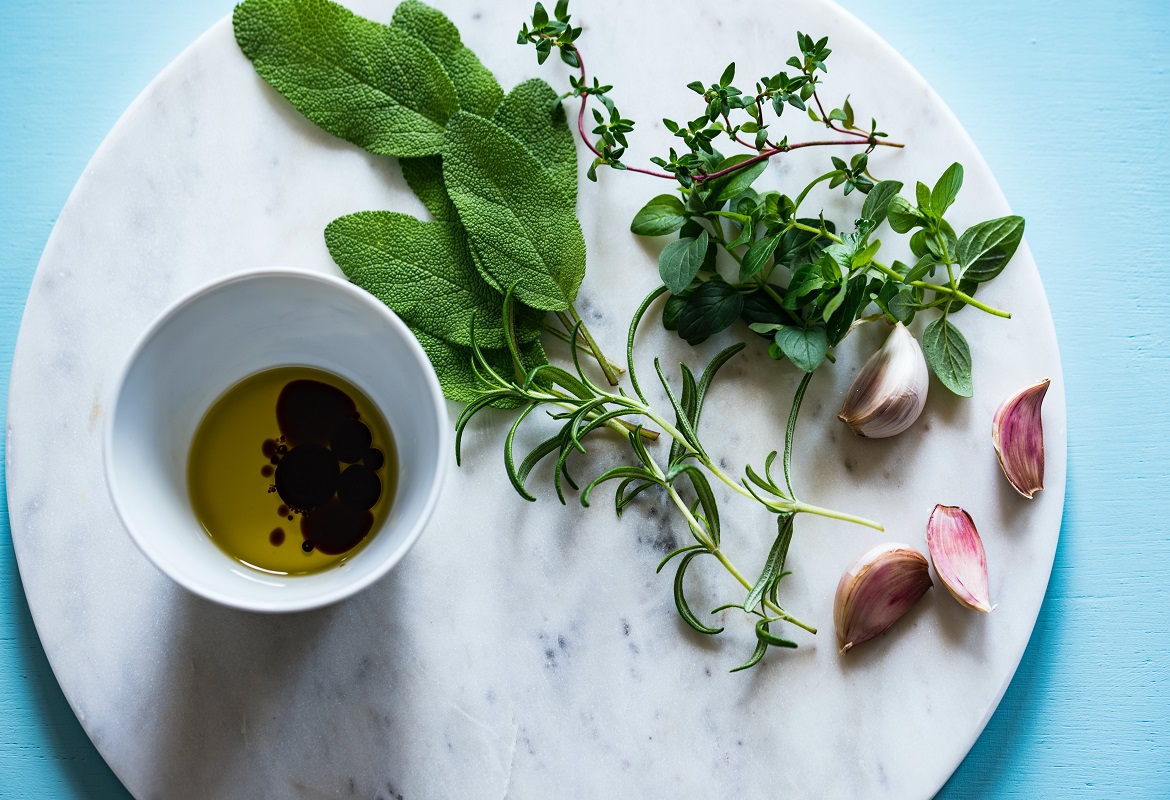
Discovering the stages of Balsamic Vinegar production
.
To discover the secrets of this unique artisanal process, you can visit our Acetaia. Our guided tours of the Acetaia begin with a walk through the vineyard where we grow the grapes we use for the production of Balsamic Vinegar. We then take visitors into the rooms where we do our daily work and show them the entire production process. After talking about all the steps to be completed, we go to the attic of the Acetaia where the ancient wooden barrels used for ageing Traditional Balsamic Vinegar of Modena PDO rest. Visits to the Acetaia end with some delicious tasting inside our Balsamic Vinegar Shop. Do not hesitate to contact us to book your visit!
The Lands of Balsamic Vinegar: Modena and its countryside
Balsamic Vinegar is a unique product with a history stretching back thousands of years. Used since ancient times as a medicine, today it is considered a gastronomic treasure. Its production requires passion, time and patience, and only a few producers still follow traditional production techniques. With this in mind, today we talk about the terres of Balsamic Vinegar: Modena and the Modena countryside.
Where Balsamic Vinegar is made...
.
Modena, a city located in the heart of Emilia Romagna, is world famous for the production of Balsamic Vinegar. This precious condiment is a symbol of the region's culinary culture and tradition and represents a true excellence of Made in Italy. This intensely flavoured and aromatic condiment originates in the territory of Modena and its surroundings.
Balsamic vinegar, in fact, is obtained from a long fermentation process of grapes harvested in these lands. Its production is regulated by precise standards that guarantee its quality and authenticity, which are followed by all the different companies that have a vinegar cellar where they produce the balsamic.
Modena and the surrounding countryside are the land of Balsamic Vinegar not only because of their origins, but also because of the climate and the consistency of the soil in these areas. These elements create the ideal conditions for making an excellent balsamic with an unmistakable flavour. The Modena Consortium, the one that regulates the production of PDO Balsamic Vinegar, requires producers to use only traditional grapes grown in the area.
The characteristics of the land of Balsamic Vinegar
.
In addition to the factors just listed, we can say that Modena and the Modenese countryside are the perfect homelands for balsamic vinegar for another reason too. In fact, the city and all the towns in the province are known for their speciality food and wine and offer excellent dishes such as tortellini, gnocco fritto, borlenghi, erbazzone and crescentine. Among the most popular products are also many local cheeses and cured meats.
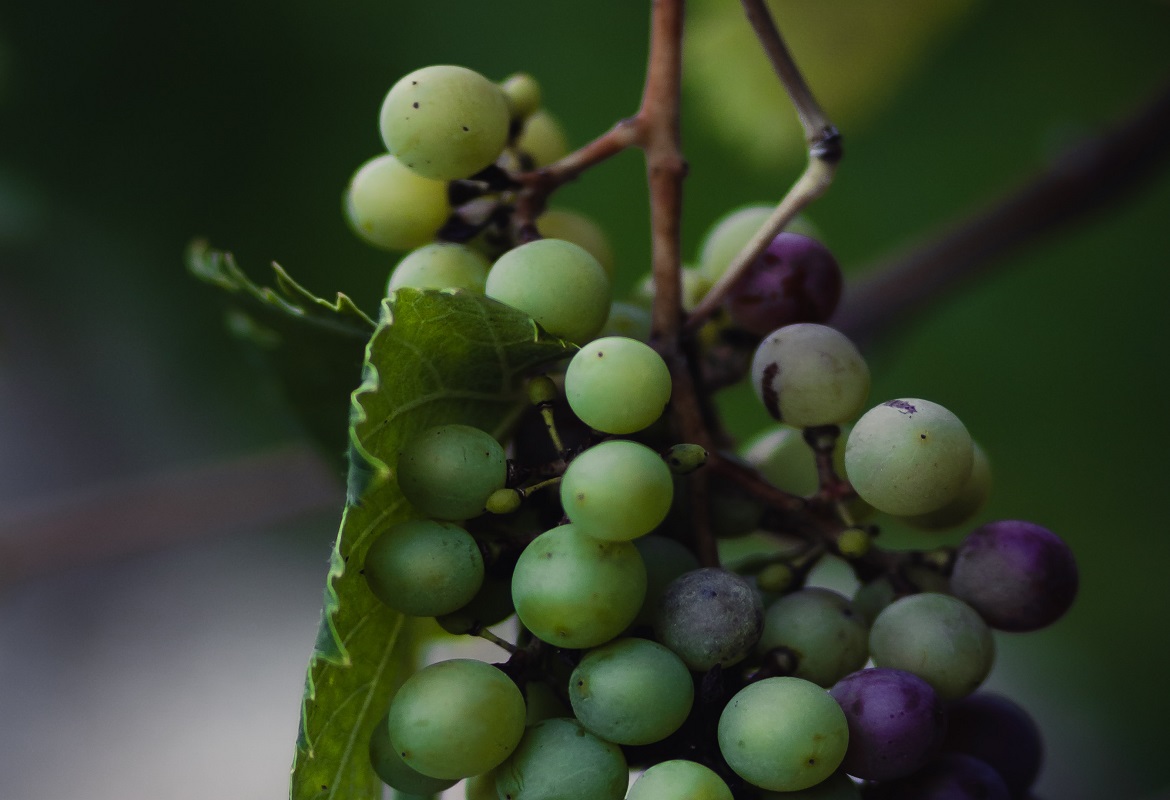
Come and discover the beauty of the land of Balsamic Vinegar and the production of this condiment
.
In conclusion, Balsamic Vinegar represents a gastronomic and cultural heritage not to be underestimated. You can discover the secrets of its production, which is regulated by precise specifications, by visiting the Lands of Balsamic Vinegar. In this respect, we suggest you stroll through the countryside to admire the immense vineyards, but also book a guided tour in our Acetaia. You can choose from several tour options and listen to the history of balsamic vinegar, some anecdotes, a description of our traditions... You can ask questions and resolve any doubts, getting to know this fantastic food in depth.
Here you can see first-hand how the Oro Nero di Modena is produced and touch the barrels in which the balsamic is aged. You can also buy and taste a good balsamic directly in our Bottega. In short, come to us as soon as possible and you will realise that a visit to the Balsamic Vinegar Estates may prove to be an even more impressive experience than expected. It will be an experience that will pleasantly enrich your palate and take your knowledge of Italian culture to the next level! We look forward to seeing you in Acetaia!
What is the difference between Traditional Balsamic Vinegar of Modena PDO and Balsamic Vinegar of Modena PGI?
Knowing the difference between Traditional Balsamic Vinegar of Modena PDO and Balsamic Vinegar of Modena PGI is important. In fact, this is the only way to make the right choice for your palate and the dishes you want to prepare. These condiments differ in organoleptic properties, but the differences do not end there.
Let's start with the acronyms...
.
What do the acronyms D.O.P. and I.G.P. mean? Having the answer to this question is certainly the first step towards understanding what the difference is between Traditional Balsamic Vinegar of Modena PDO and Balsamic Vinegar of Modena PGI. The former is the abbreviation for Protected Designation of Origin, while PGI stands for Protected Geographical Indication. These two acronyms are awards granted to food products with unique characteristics linked to geographical origin and beyond.
More specifically, we can say that the P.D.O. label indicates that the product has been prepared in a specific region and following precise production standards. This label is issued exclusively to foodstuffs that have been entirely produced within a specific geographical area according to the specifications. PGI labelling ensures that the product has a precise geographical origin and that at least one of the production steps was carried out in the specified geographical area.
The characteristics that make the difference between Traditional Balsamic Vinegar of Modena PDO and Balsamic Vinegar of Modena PGI
.
In addition to the recognition marks we have just mentioned, there are certain characteristics that make Traditional Balsamic Vinegar different from non-traditional vinegar. Traditional balsamic is a condiment made exclusively from cooked grape must, following a very slow process. It is a superior quality foodstuff that is only made in certain specific areas of Emilia-Romagna and the provinces of Modena and Reggio Emilia. It has a more or less intense flavour, depending on ageing, a dark colour and a full-bodied consistency.
Balsamic Vinegar of Modena PGI is a condiment produced following a faster process and with different ingredients than the traditional one. It is in fact made from cooked grape must, wine vinegar and a mixture of aromas and flavours. This is a decisive and substantial difference between Traditional Balsamic Vinegar of Modena PDO and Balsamic Vinegar of Modena PGI. The flavour changes, becoming less intense, although it is still delicious, and the consistency is less full-bodied than traditional.
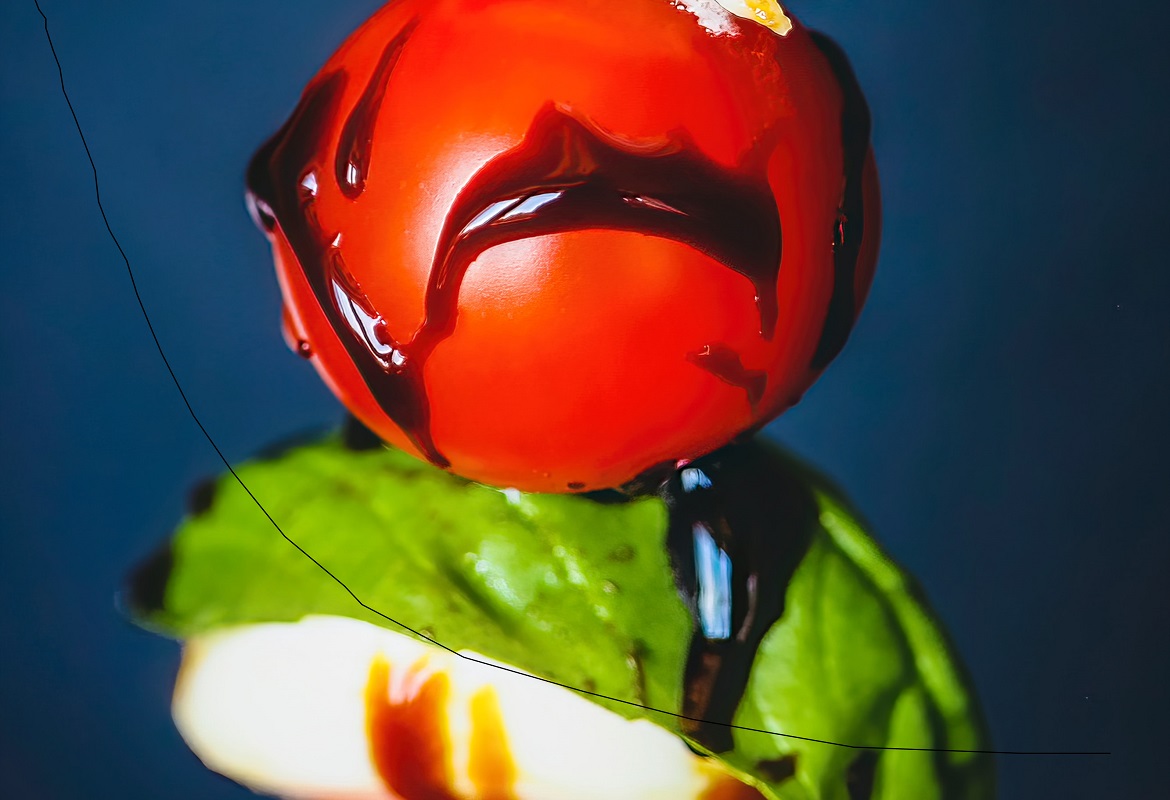
How to distinguish between the two condiments.
The first point to consider is certainly the recognition mark. The latter is printed on the bottle and the abbreviation is indicated in the product name. Therefore, even at first glance, it is not difficult to recognise the two condiments. The different organoleptic characteristics just mentioned can also help you understand which seasoning you are dealing with during a tasting session.The difference between Traditional Balsamic Vinegar of Modena PDO and Balsamic Vinegar of Modena PGI: some conclusions
.
As we have seen, there are significant distinctions between these two condiments. To learn more, we invite you to visit our Acetaia. Here you can see for yourself how they are produced and what the difference between Traditional Balsamic Vinegar of Modena PDO and Balsamic Vinegar of Modena PGI is... We look forward to seeing you!
The nutritional properties of Traditional Balsamic Vinegar of Modena
Traditional Balsamic Vinegar of Modena is a local condiment with a long history: it is one of the oldest ingredients in Italian cuisine, with roots dating back to the Middle Ages. Its history has been largely reconstructed through historical documents, stories and family traditions passed down from generation to generation. Over time, production techniques have been preserved and improved, and today we are faced with a condiment that is excellent in every respect, including the nutritional side.
The properties not to be underestimated
.
Although we only put a few drops of Traditional Balsamic Vinegar of Modena in our dishes, we certainly cannot underestimate its properties. This foodstuff, in fact, boasts a rich nutritional composition. This is mainly due to the main ingredient: grapes. It has been found that 100 millilitres of balsamic vinegar (88 calories 262) ensure a good intake of carbohydrates (17 grams) and also of:
- magnesium (12 mg),
- potassium (112 mg),
- sodium (23 mg),
- calcium (27 mg),
- phosphorus (19 mg).
The health benefits of Traditional Balsamic Vinegar of Modena
.
In addition to providing a good supply of nutrients, this food also provides important positive effects for our bodies. For example, the antioxidants present in balsamic vinegar can help prevent certain chronic diseases and also have an interesting anti-ageing effect.
This delicious condiment also boasts exceptional antibacterial and antiviral properties, which can help fight bacteria and prevent infections. The acetic acid, one of the components of balsamic, can even help control blood pressure, lower cholesterol levels and reduce the risk of cardiovascular disease.
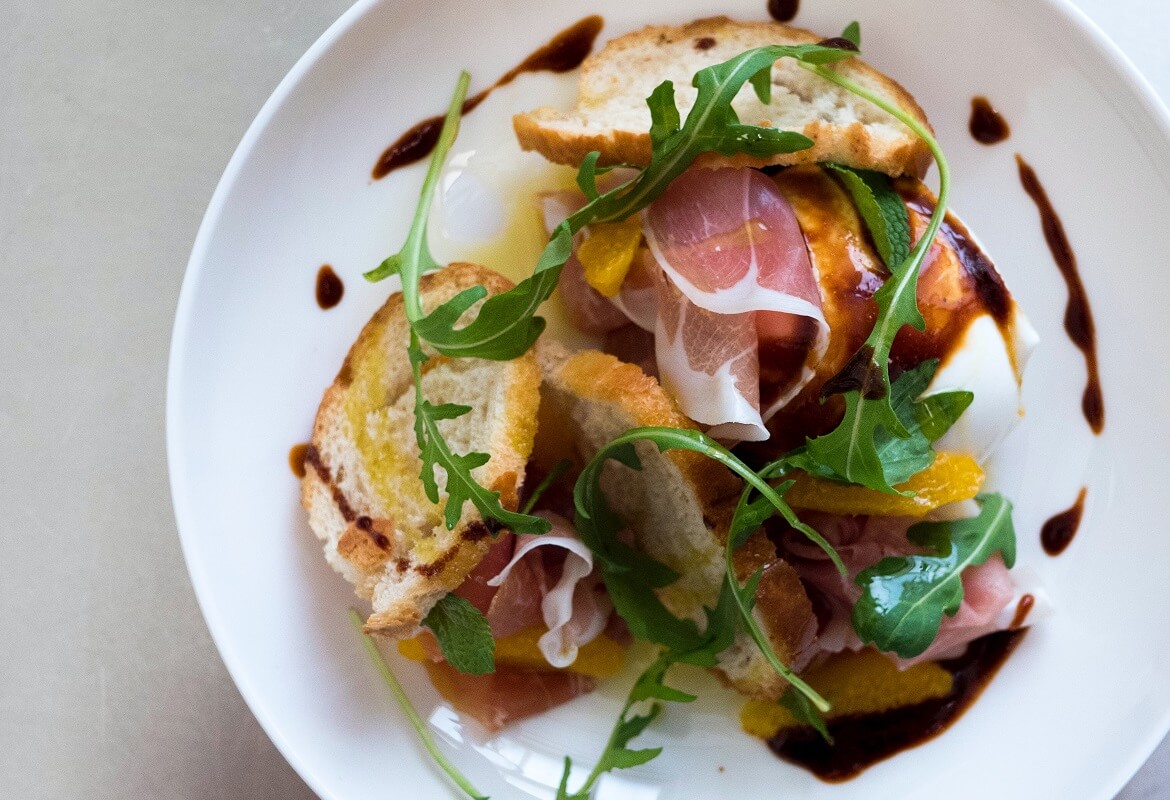
Other beneficial properties not to be underestimated
Traditional Balsamic Vinegar of Modena is capable of slowing down gastric activity and increasing the sense of satiety perceived after meals. The action of the poliphenols present in grapes should also be considered: they can strengthen the immune system, counteract the damaging effects of free radicals and slow down cellular ageing.
Due to its low caloric intake, balsamic vinegar is a condiment that can also be consumed by those on calorie-restricted diets. The consumption of vinegar, regardless of type, is generally not recommended for those suffering from gastritis or gastro-oesophageal reflux, because in some cases it may exacerbate the symptoms associated with these disorders. It is not recommended for use by people with diabetes as it may affect the amount of glucose and insulin in the blood and could therefore have an additive effect when combined with other drugs for the treatment of this condition.
The uses of Balsamic Vinegar of Modena in cooking
.
Now that we have seen what the properties of balsamic vinegar are, it is time to bring it to the table more often. We are dealing with a very versatile ingredient, perfect for enhancing the flavour of many dishes. It can be used as a salad dressing and as a component of marinades, meat or fish dishes, sauces and even desserts. It can also be used as a sugar substitute in some dessert recipes.
In any event, however, it is always a good idea to use the right product, one that is of quality and prepared just as tradition dictates. With this in mind, we invite you to taste our products. From the Balsamic Vinegar of Modena IGP to the Traditional Balsamic Vinegar of Modena PDO, all the way to the Balsamic Vinegar Dressings, we are sure to satisfy your palate!
Fruit and Balsamic Vinegar: the pairings to try
Spring is here and with its arrival, our craving for fruit has also increased. There are numerous fruits that can also be enjoyed in combination with Balsamic Vinegar, guaranteeing a unique organoleptic experience. Fruit and Balsamic Vinegar form a perfect pair: it all depends on taste, but there are some combinations that you should definitely try!
The most classic pairings
The classic and best known combination is that of strawberry and balsamic. The strawberry is a fruit rich in natural sugars, which encapsulates an intense, sweet flavour. When combined with this full-bodied condiment, the flavour of this fruit magically mixes with the characteristic taste of balsamic, creating something unique.
Another combination not to be underestimated when it comes to fruit and Balsamic Vinegar is when the delicious condiment is combined with pears. The pear is a sweet and juicy fruit that goes very well with balsamic vinegar. This is also one of the most classic and popular pairings.
Creative combinations of fruit and Balsamic Vinegar
Those who want to be a little more daring may prefer combinations that can be described as more creative and unconventional. One such is that between kiwi fruit and balsamic vinegar. The kiwi is a fruit rich in vitamin C, which goes very well with this condiment. Its sweetish, crisp flavour goes perfectly with the sweet-and-sour flavour of balsamic.
Besides the kiwi, one can try the melon. The latter is a delicious, water-rich fruit that can be served in small pieces. A drizzle of balsamic vinegar can be drizzled over these and then a light sprinkling of salt can be added. This combination of fruit and Balsamic Vinegar is definitely exceptional!
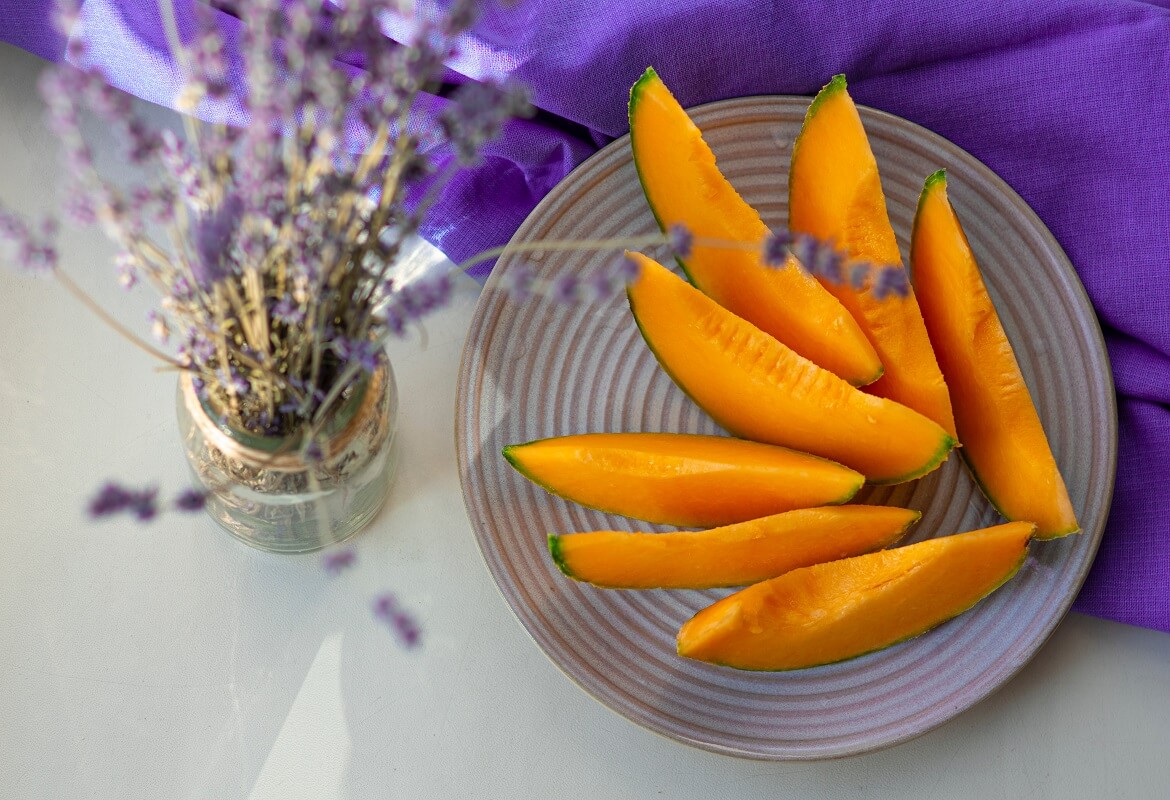
Some tips to 'bring' to the table
Balsamic vinegar is a very versatile condiment and can also be served with other fruits, such as peaches and berries... It all depends on taste and the type of menu you want to serve. The advice is to try a slice of your favourite fresh fruit with this dressing and then give a final verdict. Still talking about fruit and Balsamic Vinegar, we must say that combinations with dried fruit are not bad either!
When choosing which balsamic vinegar to use, it is important to favour only good quality products and to carefully evaluate the ageing of the vinegar: the older it is, the more intense its flavour will be. The latter is certainly a good criterion to keep in mind when choosing the type of balsamic vinegar that best suits one's taste.
Fruit and Balsamic Vinegar: Ready-to-serve pairings
In addition to fresh fruit, you can also bring to the table our organic sweet-and-sour sauces, designed especially for those who like to combine fruit and Balsamic Vinegar. We have cooked high-quality organic fruits, using artisanal processing techniques, and combined them with one of our best products. The result? Delicious sauces made from apricots, sour cherries, figs, strawberries or blueberries and Organic Balsamic Vinegar of Modena P.G.I. Try it!
Tradition encapsulated in a food and wine tasting of Modenese cuisine
Modena, despite being a municipality with less than 200,000 inhabitants, is known all over the world. Among other reasons, we should certainly mention the production of luxury sports cars, the artistic heritage, and the strong link with music through leading figures such as Luciano Pavarotti.
However, there are also other factors that have made Modena so popular all over the world, and the main one is undoubtedly its cuisine. Who in fact does not know the Emilian cuisine? In Modena, this type of cuisine becomes a true art, so much so that a food and wine tasting of Modenese cuisine is an experience that alone is worth the trip.
The delicacies of Modena and its surroundings
.
This extraordinary municipality offers an absolutely unique park of attractions that is at its best when the visitor sits down to a meal. Indeed, it is to Emilian cuisine that we owe the birth of lasagna, a typical dish known throughout the world. Emilia is also the home of Parmigiano, prosciutto and the Balsamic Vinegar of Modena. We are talking about products that reach the absolute heights of notoriety for their exquisite taste and that have become true Italian myths.
It is extraordinary to consider that all these culinary marvels come from such a small area. Modena in particular stands out for several dishes that, when you visit, you must try. Obviously, one must try the Tigelle, a true Modenese must, topped with squacquerone and mortadella or other typical cured meats. Some may prefer gnocco fritto, as an alternative. What about the lasagna? A true myth of Italian cuisine that absolutely must be tasted in Modena, in the land from which it originated. And the tortellini? This was the real dish of the festive season in the Modena area, and is an ever-popular alternative to lasagna.
We could finish our lunch with IGP cotechino and wash it down with a good Lambrusco di Modena Doc. Amidst so many delicacies to attract visitors to Modena there is also another product that we find on millions of tables around the world: Balsamic Vinegar of Modena.

The food and wine tasting
Organising a food and wine tasting is undoubtedly the best way to get to know Modena, its history and the soul of its inhabitants. In the city you will find many producers and companies that offer tastings of various types that prove to be extraordinarily interesting in many respects, as well as exquisite! Visits to vinegar cellars, for example, allow you to come into contact with an extremely fascinating environment: that of the so-called 'Black Gold of Modena'. We are talking about Balsamic Vinegar, which it will be possible to get to know, through guided tours, in all its technical and historical nuances and, above all, at the end of the tour it will be possible to taste its most delicate aromas and flavours.
A similar experience can be had with Lambrusco DOC, which stands out in the Italian wine scene for being a sparkling and lively red, very fruity, light and genuine. The gastronomic tastings in Modena are a true tradition, created to highlight the many high-quality local products, but which has become a way of living and appreciating the good things in life.
When can a Balsamic Vinegar of Modena PGI be defined as 'Aged'?
The ageing of Balsamic Vinegar is a process that enhances the great qualities of a balsamic vinegar and in order to obtain a certification for this process, certain standards must be met. Both the Aceto Balsamico di Modena IGP Invecchiato and the Aceto Balsamico Tradizionale DOP are therefore subject to quality standards that set a limit beyond which it is possible to speak of 'aged vinegar'.
The ageing of Balsamic Vinegar of Modena PGI
.
The Aceto Balsamico di Modena IGP Invecchiato is a product that is prepared for quality ageing that still allows it to be widely used on the tables of Italians. For some aged vinegars, in fact, the ageing time easily reaches 12 years and even more. Obviously, this important 'resting' phase is necessarily reflected in the cost of the product. The Balsamic Vinegar of Modena PGI, in order to meet the needs of its customers, has succeeded in perfecting a faster ageing system that keeps prices affordable.
To be included in the PGI certification, in fact, Balsamic vinegar from Modena needs to mature in wooden barrels for a period of at least sixty days. To move on to the next step, i.e. the ageing of the product with the Higher Quality Certificate, a much longer period will be required. For a Balsamic Vinegar of Modena PGI to be considered aged, it must in fact rest in barrels for at least 3 years. This is a much shorter time than that reserved for PDO certification, but without doubt the high quality is guaranteed.

Balsamic Vinegar of Modena PGI Aged: The Right Choice
.
There are many types of certification on the market for vinegar that is defined as aged. There is, for example, also the 'extravecchio' certification for Traditional Balsamic Vinegar of Modena PDO, which stipulates an ageing period of as much as 25 years. For this type of product, however, the prices are very high and could hardly reach the tables of all Italians. Moreover, the flavour and organoleptic characteristics of this type of vinegar are rather 'extreme'.
The Balsamic Vinegar of Modena PGI is the right compromise between quality and convenience. Indeed, by reducing the ageing time, it is possible to offer customers an absolutely high-quality product at more than competitive prices. Invecchiato IGP also offers a more delicate taste, is less concentrated and in many recipes is more suitable than even much older vinegars. The must for this Balsamic Vinegar is obtained from selected vineyards: Lambrusco, Sangiovese, Trebbiano, Albana, Ancellotta, Fontana and Montuni.
The appearance of Aceto Balsamico di Modena IGP Invecchiato is brown, intense and somewhat brilliant. It is not too dense, like those aged for a long time, and is easier to use. The flavour is absolutely delicate and also has some woody notes in the aroma, making it perfect for any dish: meat and fish, but also with raw and cooked vegetables. All in all, Balsamic Vinegar of Modena PGI Invecchiato proves to be a very versatile support in the kitchen, very well suited to every occasion with its typical balanced sweet and sour flavour and its highly appreciated aroma with pleasantly acetic notes.


